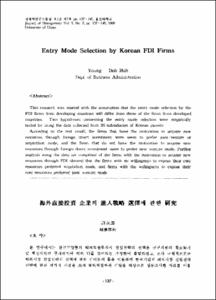골수이식의 근황
- Alternative Title
- Current Issue In Bone Marrow Transplantation
- Abstract
- Early clinical attempts of allogeneic bone marrow transplantation(BMT) were generally unsuccessful, mostly due to a lack of knowledge of histocompatibility antigen and appropriate supportive care. DUring 1970's these area developed rather rapidly, and for almost two decades, clinical allgeneic BMT has been carried out with increasing success and has expanded quickly to incorporate HLA identical siblings, HLA nonidentical related donors and recently marr9ow from unrelated volunteer donors. Allogeneic BMT have been included in the treatment of stem cell disorders such as acute and chronic leukemia, aplastic anemia, severe combined immune deficiency, Wiskott Aldrich syndrom, Fanconi's anemia, thalassemia, and sickle cell anemia, etc.
In early 1970's there was growing interest in using patient's own(autologous) bone marrow and peropheral blood stem cells in the management of malignant diseases. Now with the improvement of supportive care and technique of cryopreservation of stem cells, autologous BMT and peripheral blood stem cell transplantation(PBSCT) can be done after high dose chomotherapy in patients with chemosensitive tumors such as acute leukemia, breast cancer, testicular tumor, Ewing's sarcoma, lymphoma, neuroblastoma, ovarian cancer and small cell lung cancer. These autologous BMT and PBSCT have advantage of lack of rejection and GVHD, no need of sibling donor, and no need of anesthesia in case of PBSCT, and these approach has increased the cure rate of malignant hematologic and solid tumors.
Early clinical attempts of allogeneic bone marrow transplantation(BMT) were generally unsuccessful, mostly due to a lack of knowledge of histocompatibility antigen and appropriate supportive care. DUring 1970's these area developed rather rapidly, and for almost two decades, clinical allgeneic BMT has been carried out with increasing success and has expanded quickly to incorporate HLA identical siblings, HLA nonidentical related donors and recently marr9ow from unrelated volunteer donors. Allogeneic BMT have been included in the treatment of stem cell disorders such as acute and chronic leukemia, aplastic anemia, severe combined immune deficiency, Wiskott Aldrich syndrom, Fanconi's anemia, thalassemia, and sickle cell anemia, etc.
In early 1970's there was growing interest in using patient's own(autologous) bone marrow and peropheral blood stem cells in the management of malignant diseases. Now with the improvement of supportive care and technique of cryopreservation of stem cells, autologous BMT and peripheral blood stem cell transplantation(PBSCT) can be done after high dose chomotherapy in patients with chemosensitive tumors such as acute leukemia, breast cancer, testicular tumor, Ewing's sarcoma, lymphoma, neuroblastoma, ovarian cancer and small cell lung cancer. These autologous BMT and PBSCT have advantage of lack of rejection and GVHD, no need of sibling donor, and no need of anesthesia in case of PBSCT, and these approach has increased the cure rate of malignant hematologic and solid tumors.
- Issued Date
- 1994
- Type
- Research Laboratory
- Alternative Author(s)
- Kim, Sang-Hee
- Publisher
- 울산의대학술지
- Language
- kor
- Rights
- 울산대학교 저작물은 저작권에 의해 보호받습니다.
- Citation Volume
- 3
- Citation Number
- 1
- Citation Start Page
- 50
- Citation End Page
- 52
- Appears in Collections:
- Research Laboratory > The ULSAN university medical journal
- 파일 목록
-
-
Download
 000002025324.pdf
기타 데이터 / 471.99 kB / Adobe PDF
000002025324.pdf
기타 데이터 / 471.99 kB / Adobe PDF
-
Items in Repository are protected by copyright, with all rights reserved, unless otherwise indicated.